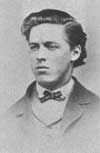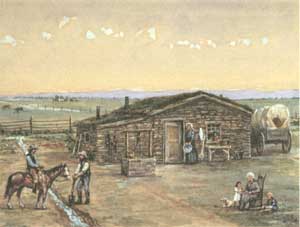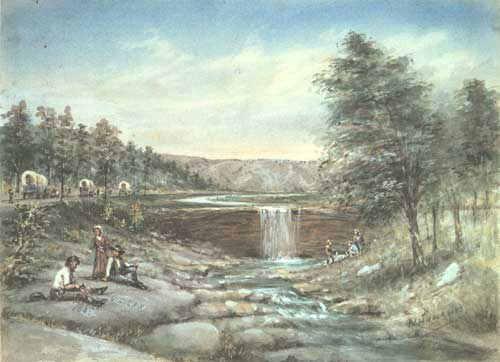
INTRODUCTION
By Marian Albright Schenk
FOREWORD
By Dean Knudsen
SECTION 1
Primary Themes of Jackson's Art
SECTION 2
Paintings of the Oregon Trail
SECTION 3
Historic Scenes From the West
 |
| A carte-de-visite of a young William Henry Jackson, dated 1864. At the time, Jackson was 21 years old and had been mustered out of the Union Army the previous year. The carte-de-visite was very popular in the 19th century and served as a combination business card and keepsake. (SCBL 3043) |

Section 2: Paintings of the Oregon Trail
ALCOVE SPRINGS
Located along the Big Blue River in eastern Kansas, Alcove Springs was one of the first landmarks reached by Oregon Trail emigrants after leaving the Missouri River at Westport. This lovely oasis, consisting of a cold-water spring surrounded by a ledge of rocks, was named by Edwin Bryant on May 27, 1846, who was traveling with the ill-fated Donner Party who passed by in the spring of that year.
It was at Alcove Springs that the Donner party suffered their first loss. On May 29, 1846, Sarah Keyes, a blind and deaf 70-year-old member of the party who had been suffering from what was called consumption—or as we know it today, tuberculosis, died. That evening she was buried nearby. The next day, George McKinstry, another man traveling with the Donner Party, made the following entry in his journal:
. . . about a half mile from Camp up the spring branch on the right hand fork is a most beautiful spring and a fall of over of 12 feet Mr Bryant of our party has named it the 'Alcove Spring' the water is of the most excellent kind the spring is surrounded with Ash Cotton wood & Cedar trees it is an excellent place to camp for a day or two to wash, recruit the cattle et I this day cut the name of the spring in the rock on Table at the top of the falls. . . 1
 |
| Initialed and dated 1936. Settlement on the treeless western plains did not increase until after 1869, when the growth of railroads made shipping of goods and produce economically feasible. (SCBL 161) |
It was this event that Jackson chose to portray in his painting of Alcove Springs.
The early pioneers who made their way onto the Plains did not stop to settle there. Despite the apparent availability of water at places such as Alcove Springs, it was generally felt that the prairie was simply to dry to be farmed. The lack of wood was another factor in their determination to continue westward, as without wood there would be no ready source of fuel or building material.
This attitude changed in the 1870s when railroads and irrigation made settling on the Plains more attractive. Some settlers followed the example of the Pawnee earth lodges and built homes from the thickly matted prairie sod. Depending on the skill of the builder, a sod house could be quite comfortable. However, the crumbling nature of the sod required a good deal of maintenance and upkeep.
1. Aubrey L. Haines, Historic Sites Along the Oregon Trail (Gerald: The Patrice Press, 1994), 46.
 |
| Alcove Springs. Signed and undated. 29.2 x 39.4 cm. (SCBL 20) |
 |
scbl/knudsen/sec2a.htm Last Updated: 14-Apr-2006 |
 |